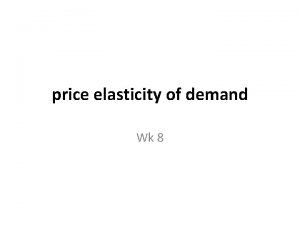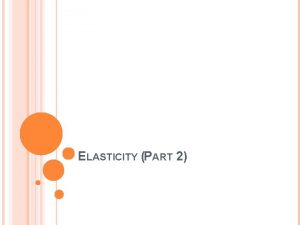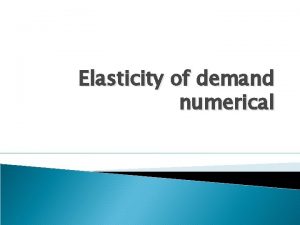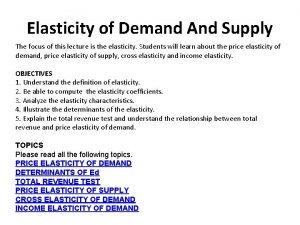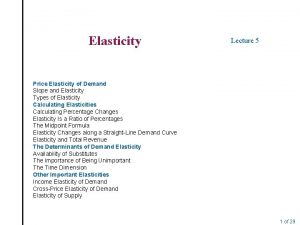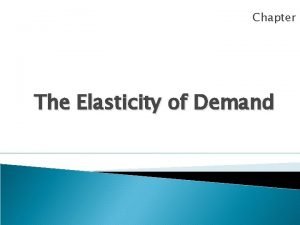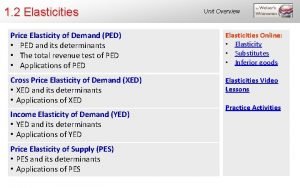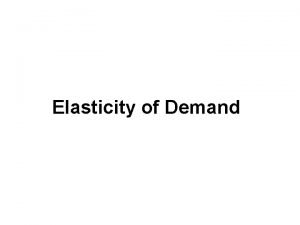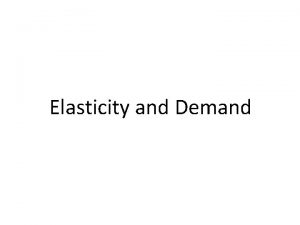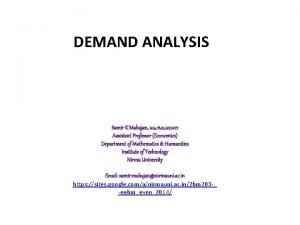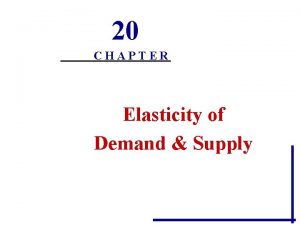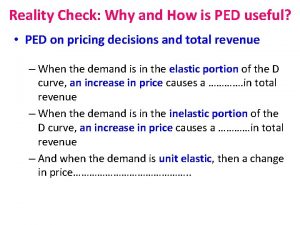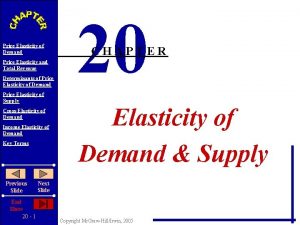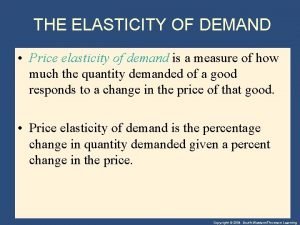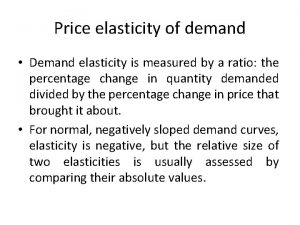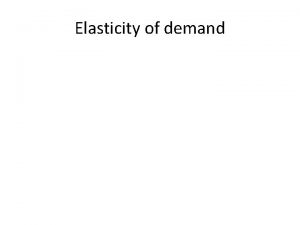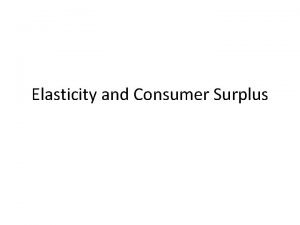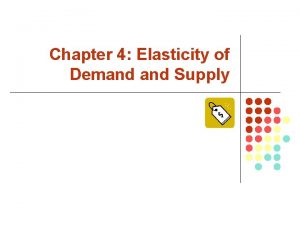Marketing Management Elasticity Price Elasticity of Demand LO
















- Slides: 16

Marketing Management Elasticity

Price Elasticity of Demand • • • LO 1 Measures buyers’ responsiveness to price changes Elastic demand • Sensitive to price changes • Large change in quantity Inelastic demand • Insensitive to price changes • Small change in quantity 4 -2

Price Elasticity of Demand Formula • Formula for price elasticity of demand Ed = LO 1 Percentage Change in Quantity Demanded of Product X Percentage Change in Price of Product X 4 -3

Price Elasticity of Demand Formula • Use the midpoint formula • Ensures consistent results Ed LO 1 Change in quantity = Sum of quantities / 2 ÷ Change in price Sum of prices / 2 4 -4

Price Elasticity of Demand Formula • Use percentages • Unit free measure • Compare responsiveness across • LO 1 products Eliminate the minus sign • Easier to compare elasticities 4 -5

Interpretation of Elasticity of Demand • Ed > 1 demand is elastic • Ed = 1 demand is unit elastic • Ed < 1 demand is inelastic • Extreme cases • Perfectly inelastic • Perfectly elastic LO 1 4 -6

Extreme Cases P D 1 Perfectly inelastic demand (Ed = 0) 0 Perfectly inelastic demand LO 1 4 -7

Extreme Cases P D 2 Perfectly elastic demand (Ed = ∞) 0 Perfectly elastic demand LO 1 4 -8

Total Revenue Test • Total Revenue = Price x Quantity • Inelastic demand • P and TR move in the same • LO 2 direction Elastic demand • P and TR move in opposite directions 4 -9

Summary of Price Elasticity of Demand: A Summary Absolute Value of Elasticity Coefficient Demand Is Impact on Total Revenue of a: Description Price Increase Price Decrease Qd changes by a larger percentage than does price Total revenue decreases Total revenue increases Greater than 1 (Ed > 1) Elastic or relatively elastic Equal to 1 (Ed = 1) Unit or unitary Qd changes by elastic the same percentage as does price Total revenue is unchanged Less than 1 (Ed < 1) Inelastic or relatively inelastic Total revenue increases Total revenue decreases LO 2 Qd changes by a smaller percentage than does price 4 -10

Determinants of Elasticity of Demand • Substitutability • More substitutes, demand is more elastic • Proportion of Income • Higher proportion of income, demand is more elastic • Luxuries vs. Necessities • Luxury goods, demand is more elastic • Time • More time available, demand is more elastic LO 1 4 -11

Price Elasticity of Supply • Measures sellers’ responsiveness to price changes • Elastic supply, producers are responsive to price changes • Inelastic supply, producers are not responsive to price changes LO 3 4 -12

Price Elasticity of Supply • Formula to compute elasticity • Es > 1 supply is elastic • Es < 1 supply is inelastic Es = LO 3 Percentage Change in Quantity Supplied of Product X Percentage Change in Price of Product X 4 -13

Cross Elasticity of Demand • Measures responsiveness of sales to • • • change in the price of another good Substitutes – positive sign Complements – negative sign Independent goods - zero Percentage change in quantity demanded of product X Ex, y = Percentage change in price of product Y LO 4 4 -14

Income Elasticity of Demand • Measures responsiveness of buyers • • to changes in income Normal goods – positive sign Inferior goods – negative sign Percentage change in quantity demanded Ei = LO 4 Percentage change in income 4 -15

Ex, y and Ei Cross and Income Elasticities of Demand Value of Coefficient Cross elasticity: Positive (Ewz > 0) Negative (Exy < 0) Description Quantity demanded of W changes in same direction as change in price of Z Type of Good(s) Substitutes Quantity demanded of X changes in Complements opposite direction from change in price of Y Income elasticity: Positive (Ei >0) Quantity demanded of the product changes in same direction as change in income Normal or superior Negative (Ei<0) Quantity demanded of the product changes in opposite direction from change in income Inferior LO 4 4 -16
 Cross-price elasticity of demand formula
Cross-price elasticity of demand formula Price elasticity of supply
Price elasticity of supply Define income elasticity of demand
Define income elasticity of demand What are the 5 determinants of price elasticity of demand
What are the 5 determinants of price elasticity of demand Price elasticity of demand numericals
Price elasticity of demand numericals Define elasticity of demand
Define elasticity of demand Elasticity of demand formula
Elasticity of demand formula Midpoint method price elasticity of demand
Midpoint method price elasticity of demand What are the 5 determinants of price elasticity of demand
What are the 5 determinants of price elasticity of demand Cross elasticity of demand
Cross elasticity of demand Total outlay method formula
Total outlay method formula Xed economics formula
Xed economics formula Promotional elasticity of demand
Promotional elasticity of demand How to calculate income elasticity of demand
How to calculate income elasticity of demand Price elasticity of demand
Price elasticity of demand Price elasticity of supply measures how responsive
Price elasticity of supply measures how responsive Yed formula
Yed formula
